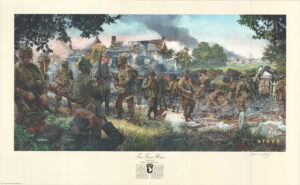Description
Image Size: 15″ x 26″
242 Public Edition (Limited Edition, Signed and Numbered)
100 Publisher Proof Edition (Limited Edition, Signed and Numbered)
100 Artist Proof Edition (Limited Edition, Signed and Numbered)
508 Military Edition (Limited Edition, Signed and Numbered)
508 PIR/82nd Airborne’s action against German anti-aircraft defenses at Operation Market Garden, WWII
September 17th, 1944 saw the initiation of Operation Market Garden, the greatest airborne assault of World War II. Forming an airborne carpet over 50 miles from north to south, three Allied airborne divisions, the U. S. 101st, 82nd and British 1st jumped into Holland in the vicinity of Eindhoven, Nijmegen and Arnhem to seize key bridges and terrain. Two of the three Parachute Infantry Regiments (P.I.R) of the 82nd Airborne Division landed in the vicinity of Groesbeek, six miles southeast of the critical bridges over the Waal River at Nijmegen. Their mission was to secure the key terrain of the Groesbeek Heights and defend the air head against a possible attack from the Reichswald in Germany, two miles to the east. Shortly after securing the Heights, the objective was to rapidly seize a Waal River and a Maas-Waal Canal bridge for British armored forced north toward Arnhem.
The 508th P.I.R. “Red Devils” had the most difficult mission, as its three battalions were spread over a wide area from Nijmegen to Groesbeek. Due to the surprise achieved by the parachute assault, the Red Devils rapidly secured the Heights against limited resistance by night fall. Soon after dark the 508th Regimental commander, COL Lindquist, ordered an attempt to seize the highway bridge spanning the Waal. Initial attempts failed as the paratroopers unexpectedly encountered elite German SS troops in downtown Nijmegen, sent via Arnhem to secure the bridge. The Nijmegen bridges would remain in German hands until 20 September.
After the initial surprise wore off, the Wehrmacht reacted swiftly to the Allied airborne assault. Hastily formed units, placed under the 406th (Landesschuetzen) Division, received orders to attack the air head from the east. Although composed of rear echelon troops, Luftwaffe personnel, and NCO school students, the Germans quickly assembled in the Reichswald and began attacking in earnest by mid-morning on the 18th, Brigadier General Gavin, the 82nd Airborne Divisions commander, had not anticipated a deliberate enemy attack so early. Since many of the Red Devils had been busy attempting to seize the bridge at Nijmegen, the German attackers – supported by 20mm Flak guns in direct fire mode – managed to drive the thin line of defending paratroopers off the Landing Zones (LZs). Gavin immediately called off the Nijmegen bridge attack and reversed his paratroopers to deal with this new threat. Clearing the area was critical because 454 gliders carrying the 82nd Airborne Division reinforcements, including 1,899 troops and artillery from the 319th and 320th Glider Field Artillery Battalions, the 456 Parachute Field Artillery Battalion, and anti-tank support were due into the LZs by early afternoon. Virtually every glider carried explosive or flammable materials – seldom had so many dangerous items been flown in a single massed formation. A “hot LZ” could prove disastrous to the vulnerable replacements.
First Sergeant Leonard Funk and his C Company, in reserve for the bridge attack, were more than seven miles from the threatened sector when they received orders to force march back towards LZ “T” northeast of Groesbeek. He formed his men at the wood line facing the LZ, to the right of B Company, in preparation for the counterattack. Although initially pinned down by fierce German small arms and 20mm anti-aircraft artillery fire, Funk and other small unit leaders rose and charged across the open LZ, eliminating the threat and ultimately routing the enemy just in time for the gliders to safely land. According to the 508th Regimental Report it was, “a movie-thriller sight of landing gliders on the LZ as the deployed paratroopers chased the last of the Germans from their 16 20mm guns.” The violent counterattack by the Red Devils of the 1st Battalion, 508th P.I.R. resulted in 30 enemy dead and 149 prisoners.
The painting depicts the culmination of the bold charge by Funk, Technician 5th Grade Robert Hupp, Private First Class James (RJ) Smith, and Private John Hardie. This foursome attacked across hundreds of meters of open ground under heavy fire, and inspired other groups of Red Devils to action. Providing a steady stream of fire in support of Funk’s lead, this group alone killed over 15 of the enemy, destroyed up to seven Flak guns, and caused over 40 Germans to surrender. For their heroic actions the four paratroopers received the Distinguished Service Cross, Silver Star, and two Bronze Stars, respectively. Funk went on to receive the Congressional Medal of Honor for actions during the Battle of the Bulge, becoming American’s most highly decorated paratrooper in World War II.
The Artist and Red Devil Association wish to express their gratitude to Dr. John Hardie for his technical assistance and descriptions of First Sergeant Funk and other paratroopers in the action depicted by “Wrath of the Red Devils.





